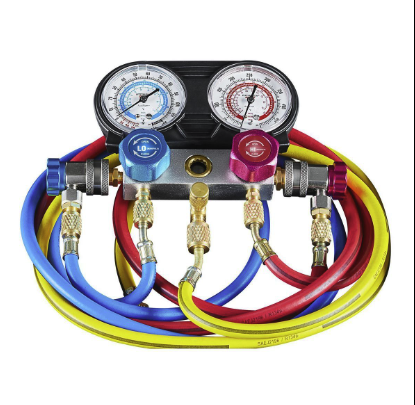Charging with Cans, Guess Again?
Unlike the old days when an R12 system could be 1⁄2 pound on either side of full and still produce cold air, an R134a system is not as forgiving. The acceptable operating window for R134a cooling is about +/- 2 oz of full. This is why technicians should recover and recharge to O.E. specifications rather than attempt to “top-off” a system that is being serviced for a low charge.
The charging method you choose will make a difference in the accuracy of the final charge amount. For greater accuracy a charging station or a 30 pound cylinder and an electronic scale is the preferred method of charging. The charging accuracy is questionable with the use of 12 oz cans.

One problem with can charging is a misunderstanding as to what is meant by 1 pound of refrigerant. Many technicians today still speak of 1 pound cans, which have not been produced since the late 1960’s. The industry also saw the use of 14 ounce refrigerant cans until the mid-1980’s. Today when we speak of 1 pound of refrigerant that amount is equal to 16 ounces. When we speak of 1 can of refrigerant that is an amount that is equal 12 ounces.
When recharging with a charging station or with a 30 pound cylinder and an electronic scale, you need to add 2 oz to the system capacity specification. This extra amount is necessary to compensate for the amount of refrigerant retained by the equipment or manifold gauge service hoses, whether you are vapor or liquid charging. So, if the vehicle calls for 28oz you will need to program in 30 oz to ensure a full charge into the vehicle’s A/C system.
NOTE: Some charging equipment requires you to add 2oz to the total charge amount, while others designs add the amount automatically. You will need to be familiar with how your equipment works. If in doubt read the equipment documentation or contact the manufacturer.
If the method of charging R134a is with 12oz cans, then you have to compensate for the amount of refrigerant to an even greater extent. You will still need to allow 2 oz for the service hoses and since you can never completely empty a can of refrigerant you will need to allow for an additional 1 oz per can. This occurs because the can’s pressure and the vehicle’s A/C system low side pressure equalizes, this stops the transfer of refrigerant. So, if the vehicle specifies 30 oz, you would require the use of three cans. This would be 36 oz, less 2 oz for the hoses and 1 oz per can times 3. That would put you within the operating window at 31 oz. True, the final charge is 1oz over the required specification, but it is as close as you can “guess” with the use of small cans.
The drawback to using 12 oz cans is when the specification calls for an amount requiring less than a whole can. Example – a system capacity of 24 oz. You may believe 2 cans would give you a full charge, but actually only places about 20 oz into the system. A 3rd can is then required to finish charging the system but you can only “guess” at the 4 oz needed. You could easily over charge the system. You will also have an undetermined amount left in the can, leaving you to “guess again” at the charge on the next vehicle being serviced.
The amount of refrigerant retained in a 12 oz can is dependent on the temperature of the refrigerant in the can. Whereas the amount of refrigerant retained in the service hoses is dependent on the length of the hoses and temperature of the refrigerant. The above examples are consistent with the refrigerant at room temperature around 85°F. When the component temperature is below 70°F, the amount retained could be twice as much. Heating the refrigerant with warm water (maximum 115°F) will increase the pressure of the refrigerant in the can and reduce the amount retained in the can to about 1⁄2oz.

Leave a Reply